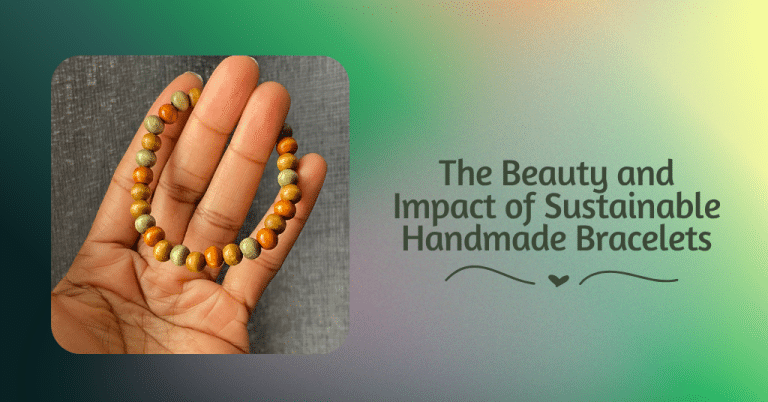From Nature’s Bounty to Elegance: An In-Depth Guide To Bio-Jewellery Materials
The Roots Of Bio-Jewellery: Ethical Sourcing And Eco-Friendly Practices
Bio-jewellery represents a remarkable fusion of fashion and sustainability, rooted in the conscientious selection of materials and ethical sourcing practices. The journey of Bio-Jewellery Materials begins with an understanding of the origins of these materials, often sourced from plants, seeds, and other natural elements. This approach ensures that the raw materials used in crafting bio-jewellery are not only beautiful but also eco-friendly and responsibly harvested.
Ethical sourcing is a cornerstone of the bio-jewellery industry, emphasising transparency and fair practices throughout the supply chain. By choosing materials that are renewable and biodegradable, bio-jewellery creators prioritise the health of the environment, reducing the carbon footprint and limiting the negative impact on ecosystems. Eco-friendly practices in bio-jewellery go beyond sourcing; they extend into production processes that minimise waste and utilise energy-efficient methods.
This sustainable approach is crucial in reducing pollution and conserving resources, aligning with the broader goals of environmental stewardship. Furthermore, eco-friendly practices often involve collaboration with local communities, supporting small-scale farmers and artisans who employ traditional techniques. This not only enriches the cultural significance of the jewellery but also fosters economic growth in underrepresented areas. Ultimately, bio-jewellery is more than an aesthetic choice; it is a statement of commitment to ethical practices and ecological balance, bridging the gap between nature and adornment with elegance and responsibility.
Natural Elements: Exploring the Core Components of Bio-Jewellery
Bio-jewellery is a fascinating intersection of nature and craftsmanship, where organic elements transform into elegant accessories. At the heart of this innovative art form are the natural ingredients that make each piece unique and sustainable. One of the most prominent materials used in bio-jewellery is seeds. They are the kernels of new life, symbolising growth and renewal while adding intricate textures and patterns to the jewellery.
Artisans skillfully incorporate seeds from various plants, such as tagua nuts or acai berries, creating pieces that are both visually stunning and environmentally friendly.
In addition to seeds, leaves are a core component of bio-jewellery. Through careful selection and preservation, designers capture the delicate venation and translucent beauty of leaves, preserving their forms in resins or natural varnishes. This process not only highlights the diversity of leaf structures but also emphasizes the beauty inherent in natural imperfections.
Wood is another integral element in bio-jewellery, offering warmth and a connection to the earth. Reclaimed wood, often from responsibly managed forests or repurposed materials, is crafted into elegant pieces that showcase its natural grain and hues. The use of natural dyes and pigments derived from flowers, fruits, or roots further enriches the collection, providing vibrant colors without the environmental impact of synthetic alternatives.
Together, these components reflect a harmonious blend of nature’s gifts, crafting adornments that celebrate the planet’s inherent beauty.
Harvesting Harmony: How Bio-Jewellery Promotes Sustainable Material Use
Bio-jewellery is an emerging field that harmonizes nature and artistry, showcasing a commitment to sustainable material use. At its core, bio-jewellery relies on responsibly sourced, organic materials, ensuring that each piece is gentle on the Earth while still possessing an undeniable elegance. The production process starts with the careful selection of seeds, leaves, and other plant-based components, which are often cultivated directly within sustainable farms or harvested from naturally abundant areas.
This method minimizes environmental impact, maintains local biodiversity, and supports the natural regeneration of ecosystems.
Moreover, the use of biodegradable and renewable resources like plant cellulose, mycelium, and biopolymers highlights the potential of non-traditional materials in reducing dependency on mined metals and synthetic substances. This approach not only curtails the carbon footprint often associated with conventional jewellery production but also promotes a circular economy where every piece can return to the earth without leaving a trace.
Through partnerships with eco-friendly artisans and sustainable cooperatives, bio-jewellery artisans ensure a transparent and ethical supply chain from sourcing to crafting. Ultimately, bio-jewellery exemplifies how fashion can innovate sustainably by harvesting harmony with nature, offering environmentally conscious consumers a way to adorn themselves without compromising their ecological values. This synergy celebrates the beauty found in both nature and human craftsmanship.
Eco-Friendly Crafting Techniques in Bio-Jewellery Production
In the world of bio-jewellery, crafting techniques play a pivotal role in ensuring the sustainability and eco-friendliness of the final products. At the heart of these techniques is the commitment to minimizing environmental impact while unlocking the aesthetic potential of nature’s elements. Bio-jewellery artisans employ an array of innovative methods that uphold these principles, beginning with the careful selection of organic and biodegradable materials.
By using seeds, leaves, and natural fibers, craftsmen ensure that the jewellery is both beautiful and sustainable. The techniques often include low-energy processes, such as cold-forming or hand-tooling, that reduce carbon footprints while eschewing the need for harmful chemicals or excessive energy consumption typical of traditional metalworking.
Additionally, artisans often adopt closed-loop production systems that focus on repurposing waste materials, allowing for the reuse of any offcuts or by-products generated during the crafting process. This approach significantly limits waste and promotes circularity within the production cycle. Emphasis is also placed on water conservation; many bio-jewellery techniques utilize minimal water, and any water used is often recycled or reclaimed.
The result is jewellery that delights in its uniqueness and tells a story of harmony with nature, where each piece is not only a testament to skilled craftsmanship but also a small, wearable symbol of a more sustainable future.
Ethical Fashion and Consumer Impact
Ethical fashion has gained momentum as consumers become increasingly aware of the environmental and social footprint of their purchases. Bio-jewellery stands at the intersection of sustainability and style, offering a compelling solution for those seeking to align their fashion choices with their values. Unlike conventional jewellery, which often relies on mining practices fraught with ecological and ethical concerns, bio-jewellery utilises sustainable resources such as plant-based materials and reclaimed natural elements.
These materials not only reduce the demand for new mineral extraction but also minimise harmful emissions and habitat disruption.
Choosing bio-jewellery allows consumers to support a responsible production process that respects both the environment and human rights. The ethical commitment of bio-jewellery brands extends beyond mere material selection. Many of these brands prioritise fair trade practices, ensuring that workers involved in all stages of production are paid fair wages and work in safe conditions. This ethical framework empowers consumers to make informed decisions that can positively influence industry standards.
Furthermore, bio-jewellery’s innovative design shines a light on the potential for fashion to be both beautiful and sustainable. As more consumers embrace these eco-friendly alternatives, the demand for ethically produced items grows, encouraging the broader fashion industry to adopt greener and more responsible practices. In this way, choosing bio-jewellery is not just a sartorial statement but an impactful choice that contributes to a more sustainable future.
The Future Of Fashion: Sustainability And Innovation In Bio-Jewellery
The future of fashion is increasingly defined by the twin forces of sustainability and innovation, particularly evident in the burgeoning field of bio-jewellery. As awareness of environmental issues grows, so does the demand for eco-friendly alternatives in every industry, with fashion being no exception. Bio-jewellery represents a confluence of art, science, and environmental stewardship, incorporating organic materials such as seeds, plant fibers, and even lab-grown components.
This shift not only redefines aesthetic value but also challenges the traditional norms of jewellery production, which often involve resource-intensive and environmentally damaging processes.
Innovation in bio-jewellery goes beyond mere material use. Technological advances, such as bioprinting and molecular engineering, are opening new horizons, enabling designers to experiment with forms and textures that were once unimaginable. This approach also addresses ethical concerns associated with mining and labor practices, offering a more transparent and responsible model for the industry. As consumers become more conscious of their environmental footprint, the appeal of bio-jewellery lies in its ability to combine beauty with a clear conscience.
The potential for personalisation and storytelling is immense, as each piece can carry a narrative tied to the unique natural elements it encompasses. With sustainability becoming a pivotal benchmark for future fashion, bio-jewellery stands at the forefront of a transformative movement, marrying elegance with ecological integrity.






Leave a Reply